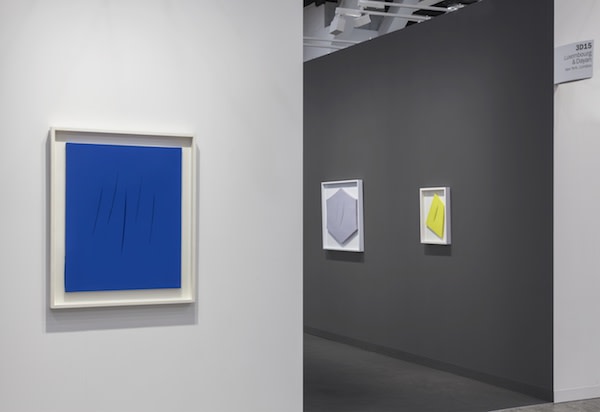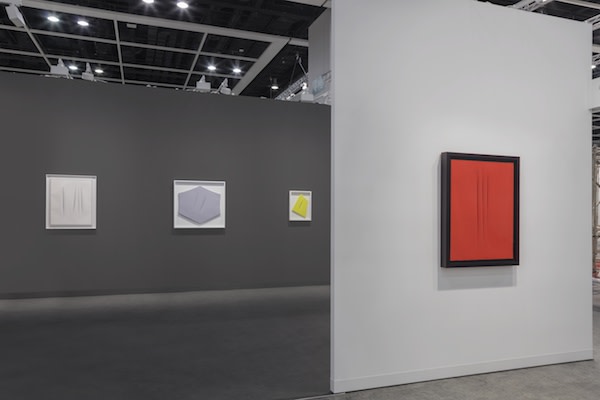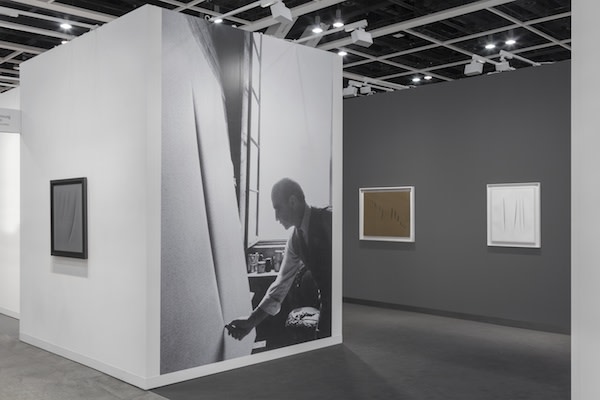Luxembourg & Dayan is pleased to announce its inaugural participation in Art Basel Hong Kong with the exhibition Lucio Fontana: I Tagli, a grouping of the renowned Italian artist's "slashed" paintings of the 1950s and 1960s. The gallery's presentation spotlights a pivotal moment in the career of Fontana (1899-1968), a 20th century titan whose paintings and sculptures investigate the concept of space, suggesting the infinite beyond our worldly confines.
The precise slits in Lucio Fontana's tagli —which he produced between 1958 and 1968—give the impression of unearthing a cosmic void from beneath the canvas. The tagli were central to Fontana's inquiry into the intersection of tangible and conceptual space, the finite canvas and the potentially boundless expanse of three- and four-dimensions. Naming these bodies of work together Concetti spaziali, or "spatial concepts," Fontana intended his violation of the painting's surface to be a critical but ultimately constructive gesture-a "creative nothing.”¹ It enabled him to venture beyond pictorial formalism towards a dynamism that nonetheless gives the viewer, to use his words, "an impression of spatial calm, of cosmic rigor, of serenity in infinity."²
Since its founding, Luxembourg & Dayan has been deeply engaged in re-examining the artistic developments of postwar Europe, through exhibitions with artists ranging from Alberto Burri and Michelangelo Pistoletto, to Domenico Gnoli and Martial Raysse. The postwar years witnessed the intersection of sociopolitical revolutions and artistic re-evaluations of painting. Fontana was at the forefront of this upheaval. Along with such fellow Italian artists as Burri, Piero Manzoni, and Rodolfo Aricò, he pushed the two-dimensional canvas out of representational or purely expressive registers to rethink the role of painting both philosophically, and as a concrete object in lived space.
The presentation is accompanied by an illustrated publication featuring a text by art historian Pia Gottschaller.
About the Artist
Lucio Fontana was born on February 19, 1899, in Rosario de Santa Fé, Argentina, to an Italian father and an Argentinean mother. He lived in Milan from 1905 to 1922 and then moved back to Argentina, where he worked as a sculptor in his father's studio for several years before opening his own. In 1926, he participated in the first exhibition of Nexus (formed in 1907), a group of young Argentinean artists in Rosario de Santa Fé. On his return to Milan in 1928, Fontana enrolled at the Accademia di Belle Arti di Brera, which he attended for two years.
The Galleria Il Milione, Milan, organized Fontana's first solo exhibition in 1930. In 1934, he joined the group of abstract Italian sculptors associated with the gallery. The artist traveled to Paris in 1935 and joined the group Abstraction-Création (Abstraction Creation, 1931-36). The same year, he developed his skills in ceramics in Albisola, Italy, and later at the Sèvres factory, near Paris. In 1939, he joined the Milanese anti-Fascist group Corrente (Current, 1938-43). It was during this period that he also intensified his lifelong collaboration with architects.
In 1940, Fontana moved to Buenos Aires. With some of his students he founded the Academia de Altamira in 1946, from which emerged the "Manifesto blanco" ("White manifesto," 1946). He moved back to Milan in 1947 and in collaboration with a group of writers and philosophers signed the "Primo manifesto dello spazialismo" ("First manifesto of spatialism," 1947). He would subsequently explore these new ideas with his Concetti spaziali (Spatial concepts, 1949-68).
The year 1949 marked a turning point in Fontana's career; he concurrently created his first series of paintings in which he punctured the canvas with buchi (holes), and his first spatial environment-a combination of sculptures, fluorescent paintings, and black lights to be viewed in a darkened room. The latter work soon led him to employ neon tubing in ceiling decoration. In the early 1950s, he participated in Italian Art Informel exhibitions. During this decade, he explored working with various effects, such as slashing and perforating, in both painting and sculpture. The artist visited New York in 1961 during a show of his work at the Martha Jackson Gallery. In 1966, he designed opera sets and costumes for La Scala, Milan.
In the last year of his career, Fontana became increasingly interested in the staging of his work in the many exhibitions that honored him worldwide, as well as in the idea of purity achieved in his last white canvases. These concerns were prominent at the 1966 Venice Biennale, for which he designed the environment for his work, and at the 1968 Documenta, Kassel, West Germany. Fontana died on September 7, 1968, in Comabbio, Italy.
About Luxembourg & Dayan
Luxembourg & Dayan presents curated, museum-quality exhibitions of works by modern masters and contemporary artists in its spaces in New York and London. Since opening, the gallery has presented a number of critically-acclaimed exhibitions, ranging from historical presentations of artists, such as Alberto Giacometti, Alberto Burri, and Lucian Freud, to thematic survey exhibitions, which since 2011 have included Grisaille, Unpainted Paintings, Thick Paint, The Shaped Canvas, Revisited, and Word By Word.
Media contact
Andrea Schwan, Andrea Schwan Inc. info@andreaschwan.com, +1 917 371 5023
Gair Burton, Pickles PR, gair@picklespr.com, +44 7402 784 470
Simone Woo, Jiang Hildebrandt Associates Ltd., swoo@jianghildebrandt.com, +852 9260 1455
1. L. Fontana, quoted in C. Lonzi, Autoritratto, pp. 319-22; in Lucio Fontana (exh. cat.), Palazzo della Esposizioni, Rome: Electa, 1998, p. 246.
2. L. Fontana, quoted in E. Crispolti, Lucio Fontana: Catalogo ragionato di sculture, dipinti, ambientazioni, Vol. I, Milan: Skira, 2006, p. 105.
Artwork © 2017 Artists Rights Society (ARS), New York / SIAE, Rome. Photo: Guillaume Ziccarelli
Lucio Fontana working, artist's studio, Paris, 1958-1973. Photograph: Shunk-Kender © J. Paul Getty Trust. Getty Research Institute, Los Angeles (2014.R.20)



